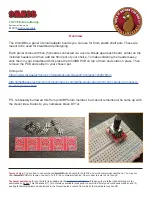
Laser Beam Parameters
5.3
Three parameters predict how a radially symmetric beam will propagate, namely:
1.
Waist width (W
0
)
2.
Waist Location (Z
0
)
3.
Far field divergence angle (Θ)
Non-radially symmetric beams are characterized by a set of these parameters for both the X and Y axes. Since
the methods for measuring the X and Y axes are the same, only one set will be referenced in the following
descriptions.
The term beam width is used instead of beam diameter or radius since traditional beam
measurement practices compute full beam widths along both X and Y axes. Also, beam diameter and
beam radius suggest that the beam is circular. A laser may be circular, but this is considered to be a
special case.
Different conventions and symbols are utilized by various authors. In the descriptions that follow we
use W to represent the full beam width, while ISO uses d
σx
and d
σy
for the full beam widths and d
σ
for diameter and others use W or w to represent ½ the beam width (or radius).
Θ is used to describe the full angle divergence. An “f” is used to indicate the focal length of the lens.
When a beam is transformed through a lens the input beam parameters are designated by a 1 and
the output parameters are designated by a 2.
All distances are described along the axis of propagation or Z axis and are measured relative to the
locus of the transforming lens. Distances z
1
are measured before the lens and z
2
measured after
passing through the lens.
W
0
and Z
0
represent a beam waist width and its waist location, respectively. Z
R
is used to represent
the Rayleigh length from the beam waist location Z
0
. In the ISO procedures subscripts x and y are
added to represent the axial directions. Only one axis is described here so the subscripts are omitted.
Summary of Contents for BeamSquared
Page 10: ......
Page 15: ...BeamSquared Optical Train Dimensions 1 4 ...
Page 75: ...400mm Focal Length Lens M2 1 500mm Focal Length Lens M2 1 ...
Page 87: ......
















































